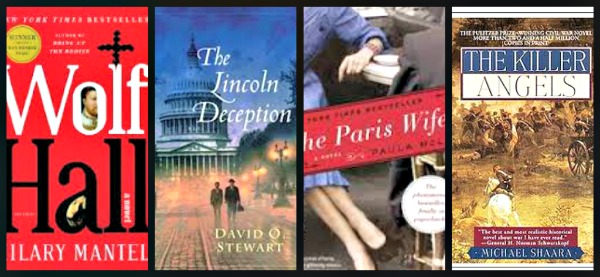Historical fiction is flourishing, and its advantages are many. For readers, it combines the familiar with the unknown, as novelists imagine the motivations and thoughts of historical figures. For writers, it provides grounding. Certain characters are already known and even defined. Better yet, the real world produces the most improbable characters. What fiction writer would dare create a character so complex and powerful as Abraham Lincoln? Yet historical fiction comes in many flavors. Here, for starters, are eight:

Straight-up. Like
Shakespeare’s history plays, some historical fiction offers a straightforward
imagining of an event through real and fictional characters, placing the reader
in the center of it. Because the novelist can supply characters’ thoughts and
motivations, not to mention entertaining dialogue, the resulting story often
goes down more smoothly than historical narratives, which cannot stray from the
facts. That was certainly true for Michael Shaara’s brilliant rendering of the
Battle of Gettysburg in The Killer Angels, or E.L.
Doctorow’s retelling of the Dutch Schultz gangster story in Billy Bathgate.
Inside-out. Some historical novelists
take the heroes and scoundrels of history and flip them. Hilary Mantel’s
smashing success with Wolf Hall and Bring Up The Bodies begins with her audacious suggestion that
St. Thomas More was a narrow-minded, mealy-mouthed cleric, while his antagonist
— the oft-reviled Thomas Cromwell — was a statesman of vision and integrity. Gore
Vidal employed this gambit repeatedly. His Burr celebrates the
duelist and alleged traitor, while Hollywood portrays Warren
G. Harding as a shrewd and wise political leader, and 1876 plumps for the excellence of President
Ulysses Grant.
Upside-down. Some novelists refuse
to settle for reinterpreting history: they change it, opening readers’ minds to
the what-might-have-beens. Often called “alternative history,” these include
Stephen L. Carter’s intriguing The Impeachment of Abraham Lincoln, which wonders how things might have
turned out if Lincoln had survived the bullet at Ford’s Theatre. Robert Harris’
Fatherland imagines a
Europe after Nazi victory in World War II. In The Plot Against America, Philip Roth
asked what America would have become if Charles Lindbergh had run for — and won
— the presidency in 1940.
The Rosencrantz Maneuver. First popularized by Tom Stoppard in his
takeoff of “Hamlet,” “Rosencrantz and Guildenstern are Dead,” this maneuver
exalts a bit player in a large drama, simultaneously cutting the heroes down to
size and offering readers a new window into the story. In The Blood of Heaven, Kent Wascom intriguingly reworked the
Aaron Burr story (that man again) through the eyes of the brothers Kemper, who
are only occasionally remembered for raising hell in the short-lived Spanish
colony of West Florida.
Historical Mysteries. Pioneered by
Josephine Tey, these books set fictional characters on the trail of an
historical mystery, often from another era. In Tey’s The Daughter of Time, a Scotland Yard detective in 1950
unravels the mystery of the 1483 murder of the underage King Edward V in the
Tower of London. My own effort, The Lincoln Deception, sets a pair of mismatched investigators
on the trail of the John Wilkes Booth conspirators and whoever was behind them.
Historical Crime-Fighters. A popular breed of historical novel
places the crime thriller back in time, with a key historical figure at the
center. Louis Bayard’s The Pale Blue Eye explores a
murder in New York City that includes the struggling Edgar Allan Poe, while
Daniel Stashower’s Harry Houdini Mysteries
uses the magician and escape artist to solve baffling crimes.
Novelists’ Wives. There’s no
denying the recent spate of books telling the interior stories of those
long-suffering women yoked to writer-husbands. There’s The Paris Wife by Paula McLain (Hemingway), and
three about Zelda Fitzgerald: Therese Anne Fowler’s Z, R. Clifton
Spargo’s Beautiful Fools, and Erika
Robuck’s Call Me Zelda.
Fictional Historical Fiction (Historical Fiction Fiction?). An impressive range of novelists place their stories in someone else’s novel — that is, the author borrows the setting and characters of the first novel and vamps on it. Jane Austen is so regularly honored (and pillaged) in this fashion that one website puts out an annual list of the “Top 20 Jane Austen-Inspired Books.” In March, Geraldine Brooks followed the wartime career of the long-absent father from Louisa May Alcott’s Little Women, while Ahab’s Wife, by Sena Jeter Naslund, imagines the story of the stay-at-home wife of Melville’s unforgettable ship captain.
So, which breeds have I missed?
David O. Stewart has written several historical
narratives and published his first historical novel, The Lincoln Deception,
last year. On Sunday, March 9, at 2 p.m.,
he will be part of a panel discussion of historical fiction at the Writer’s Center in
Bethesda, along with Daniel Stashower, Kent Wascom, and moderator Emily Mitchell, who is author of an
historical novel about Edward Steichen, The Last Summer of the World.

